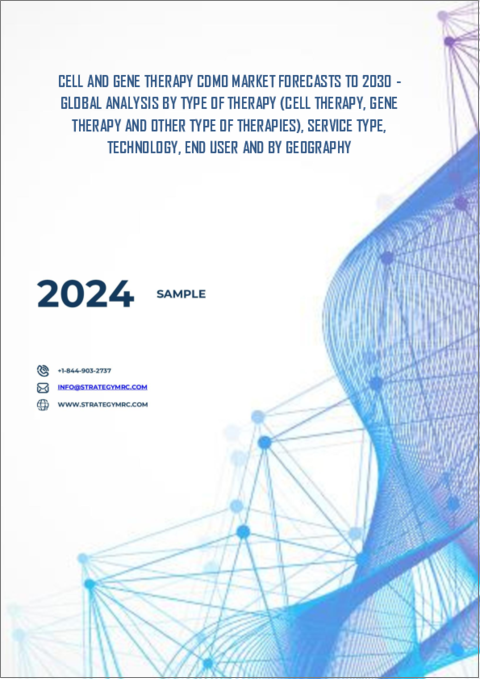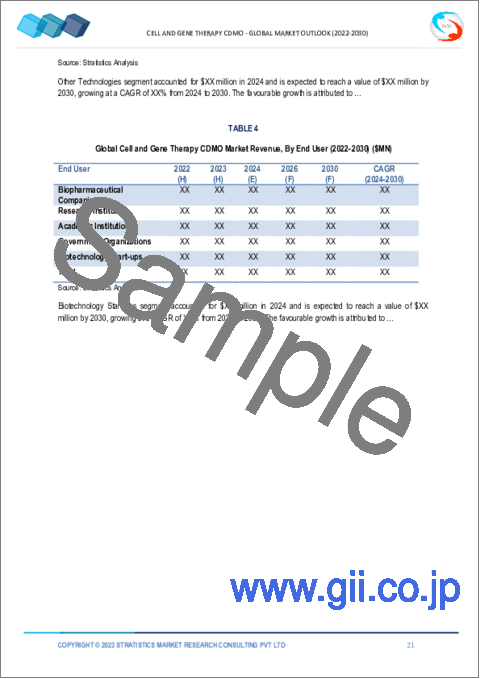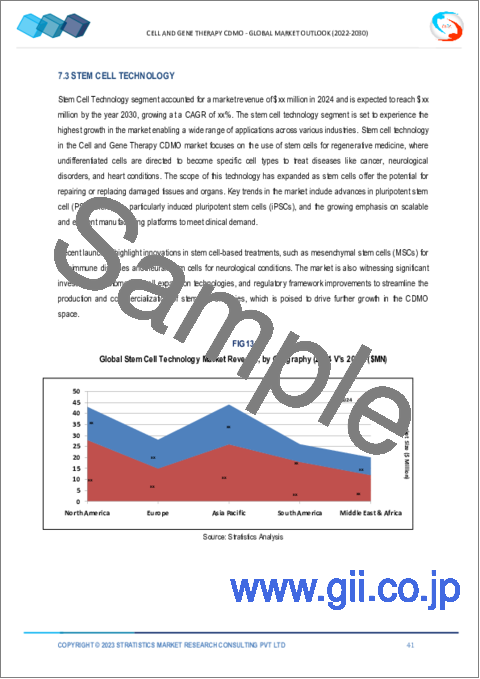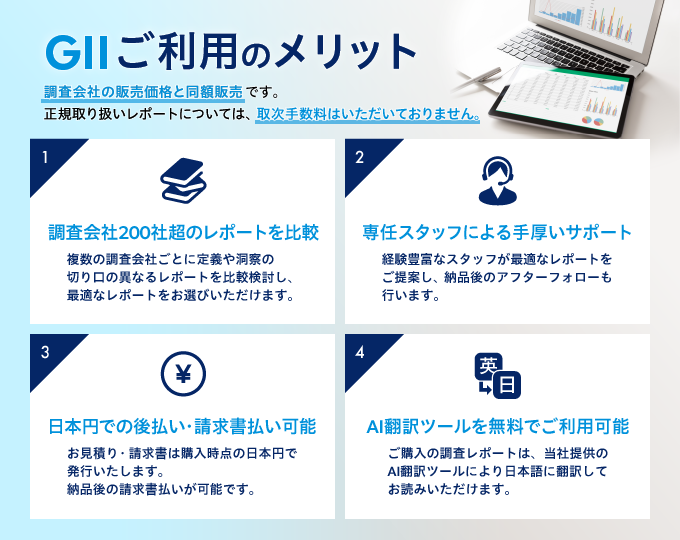|
|
市場調査レポート
商品コード
1577256
細胞および遺伝子治療CDMO市場の2030年までの予測:治療タイプ別、サービスタイプ別、技術別、エンドユーザー別、地域別の世界分析Cell and Gene Therapy CDMO Market Forecasts to 2030 - Global Analysis By Type of Therapy (Cell Therapy, Gene Therapy and Other Type of Therapies), Service Type, Technology, End User and By Geography |
||||||
カスタマイズ可能
|
|||||||
| 細胞および遺伝子治療CDMO市場の2030年までの予測:治療タイプ別、サービスタイプ別、技術別、エンドユーザー別、地域別の世界分析 |
|
出版日: 2024年10月10日
発行: Stratistics Market Research Consulting
ページ情報: 英文 200+ Pages
納期: 2~3営業日
|
全表示
- 概要
- 図表
- 目次
Stratistics MRCによると、世界の細胞および遺伝子治療CDMO市場は2024年に64億8,000万米ドルを占め、2030年には311億4,000万米ドルに達すると予測され、予測期間中のCAGRは29.9%で成長する見込みです。
細胞および遺伝子治療CDMO(Contract Development and Manufacturing Organization)は、細胞の開発・製造・商業化においてバイオ医薬品企業を支援する専門サービスプロバイダーです。これらの組織は、プロセス開発、臨床・商業製造、薬事サポートを含むエンド・ツー・エンドのサービスを提供しています。CDMOと提携することで、バイオ医薬品企業は複雑で資源集約的な業務を外注することができ、規制遵守とスケーラブルな生産を確保しながら、研究、技術革新、製品上市に集中することができます。
細胞・遺伝子治療に対する需要の増加
バイオテクノロジー企業では、遺伝性疾患、がん、慢性疾患に対する新規治療法の創出に注力しており、細胞・遺伝子治療の需要が増加しているため、遺伝子編集、ウイルスベクター生産、細胞培養などの複雑なプロセスにおける専門知識を持つCDMOに依存しています。CDMOは、スケーラブルな製造、規制遵守、市場投入までの時間の短縮を提供することで需要の高まりに対応し、バイオテクノロジー企業がインフラに多額の投資をすることなく研究とイノベーションに集中できるようにすることで、市場の成長を加速させています。
高コストと複雑な製造工程
高コストと複雑な製造プロセスには、高度に専門化された施設や設備が必要であり、運用コストを押し上げています。加えて、厳格な品質管理対策と個別化された製造工程が必要なため、コストはさらに上昇します。これらの要因により、CDMOが規模の経済を達成することは困難となり、収益性が制限され、市場成長の妨げとなる可能性があります。その結果、細胞治療や遺伝子治療の製造に関連する高コストは、新規参入企業にとって参入障壁となり、患者へのこれらの治療法の提供を制限し、市場成長の妨げとなる可能性があります。
提携とパートナーシップ
バイオファーマ企業、学術機関、CDMOにおける共同研究やパートナーシップは、研究を加速し、臨床開発を合理化し、製造規模を拡大するために協力しています。これらの提携は、特に複雑で高コストの細胞・遺伝子治療開発において、より迅速なイノベーション、コスト分担、リスク軽減を可能にします。各パートナーの強みを活かすことで、提携は効率的な技術移転、規制当局のサポート、市場参入を促進し、最終的にCDMO市場の成長と成功を後押しします。
規制と品質の問題
細胞および遺伝子治療CDMO市場は、規制・品質上の失敗によるコスト増、風評被害、製品開発の遅延、市場アクセスの制限、法的懸念など、いくつかの悪影響を受けやすいです。CDMOの新規事業やパートナーシップの獲得能力は、コンプライアンス違反によって阻害される可能性があり、その結果、罰則、リコール、操業停止に至る可能性があります。さらに、品質不良はCDMOの信頼性を損ない、見込み顧客を減少させ、市場の成長を妨げる可能性があります。
COVID-19の影響
COVID-19パンデミックは、サプライチェーン、臨床試験、規制プロセスに混乱を引き起こし、細胞および遺伝子治療CDMO市場に大きな影響を与えました。多くのCDMOは、研究室へのアクセス制限や労働力不足により、プロジェクトスケジュールの遅れに直面しました。しかし、パンデミックはまた、バイオ製造能力への投資とデジタル技術の採用を加速させ、業務効率を高めました。新たな健康危機に対する迅速な治療対応への需要は、柔軟でスケーラブルなCDMOサービスの重要性を浮き彫りにしました。
予測期間中、細胞治療分野が最大となる見込み
細胞治療分野は、がん、自己免疫疾患、変性疾患などの疾患に対する画期的な治療を提供することで、予測期間中に最大の市場シェアを占めると予測されます。CAR-Tや幹細胞治療などの細胞治療には高度な専門性が要求されるため、多くのバイオテクノロジー企業がCDMOに委託しています。個別化医療や再生医療への需要の高まりは、臨床使用への生産規模の拡大という課題と相まって、CDMOへの依存の高まりにつながっています。このセグメントの急速な進歩と規制当局の承認が、市場の成長をさらに後押ししています。
ウイルスベクター分野は予測期間中に最も高いCAGRが見込まれる
治療用遺伝子を標的細胞に送達する上で不可欠な役割を果たすことから、ウイルスベクター分野は予測期間中、ウイルスベクター市場で最も高いCAGRを示すと予測されます。革新的な遺伝子治療の需要が高まるにつれ、アデノウイルス、レンチウイルス、アデノ随伴ウイルスなどのウイルスベクターは、効果的な遺伝子導入に不可欠なツールとなっています。ウイルスベクターの生産を専門とするCDMOは、臨床試験や商業化に不可欠な開発、製造、品質管理などのサービスを提供しています。さらに、ベクター設計と生産技術の進歩が有効性と安全性を高め、需要をさらに促進し、バイオ医薬品企業がこの分野の専門知識を持つCDMOと提携することを後押ししています。
最大のシェアを占める地域:
アジア太平洋地域は、バイオテクノロジーへの投資の増加、ヘルスケアインフラの改善、革新的な治療法に対する需要の高まりにより、予測期間中に最大の市場シェアを占めると予測されます。中国、日本、インドなどの国々が主要プレーヤーとして台頭しており、研究開発を促進する政府のイニシアチブの恩恵を受けています。この地域の多様な患者層は個別化医療に十分な機会を提供する一方、現地のCDMOは国内外の顧客に対応するために能力を拡大しています。世界製薬企業との提携は、細胞・遺伝子治療の競合情勢におけるこの地域の競争力をさらに高めています。
CAGRが最も高い地域:
推定・予測期間中、研究開発への多額の投資により、北米地域が最も高い成長率を記録すると予測されます。同地域は、強固なインフラ、先進技術、バイオテクノロジー企業や学術機関の集積を誇っています。さらに、FDAのような機関からの規制上の支援により、細胞・遺伝子治療の承認プロセスが加速しています。遺伝性疾患の有病率の上昇は、オーダーメイド治療への需要をさらに煽り、北米をこの急成長市場の主要プレーヤーとして位置づけています。
無料のカスタマイズサービス
本レポートをご購読のお客様には、以下の無料カスタマイズオプションのいずれかをご利用いただけます:
- 企業プロファイル
- 追加市場プレーヤーの包括的プロファイリング(3社まで)
- 主要企業のSWOT分析(3社まで)
- 地域セグメンテーション
- 顧客の関心に応じた主要国の市場推計・予測・CAGR(注:フィージビリティチェックによる)
- 競合ベンチマーキング
- 製品ポートフォリオ、地理的プレゼンス、戦略的提携に基づく主要企業のベンチマーキング
目次
第1章 エグゼクティブサマリー
第2章 序文
- 概要
- ステークホルダー
- 調査範囲
- 調査手法
- データマイニング
- データ分析
- データ検証
- 調査アプローチ
- 調査情報源
- 1次調査情報源
- 2次調査情報源
- 前提条件
第3章 市場動向分析
- 促進要因
- 抑制要因
- 機会
- 脅威
- 技術分析
- エンドユーザー分析
- 新興市場
- COVID-19の影響
第4章 ポーターのファイブフォース分析
- 供給企業の交渉力
- 買い手の交渉力
- 代替品の脅威
- 新規参入業者の脅威
- 競争企業間の敵対関係
第5章 世界の細胞および遺伝子治療CDMO市場:治療タイプ別
- 細胞療法
- 自己細胞療法
- 同種細胞療法
- CAR-T細胞療法
- 遺伝子治療
- 生体内遺伝子治療
- 体外遺伝子治療
- その他の治療タイプ
第6章 世界の細胞および遺伝子治療CDMO市場:サービスタイプ別
- プロセス開発
- 製造業
- 細胞培養
- ベクター製造
- 精製
- 配合
- 分析サービス
- 品質保証と品質管理(QA/QC)
- 規制サポート
- 充填および仕上げ作業
第7章 世界の細胞および遺伝子治療CDMO市場:技術別
- ウイルスベクター
- アデノウイルスベクター
- レンチウイルスベクター
- アデノ随伴ウイルスベクター
- 非ウイルス性の方法
- CRISPR/Cas9
- トランスポゾン
- プラスミドDNA
- 幹細胞技術
- T細胞受容体
- その他の技術
第8章 世界の細胞および遺伝子治療CDMO市場:エンドユーザー別
- バイオ医薬品企業
- 研究機関
- 学術機関
- 政府機関
- バイオテクノロジースタートアップ
第9章 世界の細胞および遺伝子治療CDMO市場:地域別
- 北米
- 米国
- カナダ
- メキシコ
- 欧州
- ドイツ
- 英国
- イタリア
- フランス
- スペイン
- その他欧州
- アジア太平洋
- 日本
- 中国
- インド
- オーストラリア
- ニュージーランド
- 韓国
- その他アジア太平洋地域
- 南米
- アルゼンチン
- ブラジル
- チリ
- その他南米
- 中東・アフリカ
- サウジアラビア
- アラブ首長国連邦
- カタール
- 南アフリカ
- その他中東とアフリカ
第10章 主な発展
- 契約、パートナーシップ、コラボレーション、合弁事業
- 買収と合併
- 新製品発売
- 事業拡大
- その他の主要戦略
第11章 企業プロファイリング
- Aldevron
- Atara Biotherapeutics, Inc.
- Bluebird Bio, Inc.
- Bristol-Myers Squibb(Celgene)
- Catalent, Inc.
- Cytiva(part of GE Healthcare)
- Fujifilm Diosynth Biotechnologies
- Kite Pharma(a Gilead Company)
- Lonza Group AG
- NantKwest, Inc.
- Novartis AG
- Paragon Bioservices, Inc.
- Pioneer BioTech
- Precision BioSciences, Inc.
- Regenative Labs
- Roche
- Sangamo Therapeutics, Inc.
- Thermo Fisher Scientific Inc.
- VivaCell Biotechnology
- WuXi AppTec
List of Tables
- Table 1 Global Cell and Gene Therapy CDMO Market Outlook, By Region (2022-2030) ($MN)
- Table 2 Global Cell and Gene Therapy CDMO Market Outlook, By Type of Therapy (2022-2030) ($MN)
- Table 3 Global Cell and Gene Therapy CDMO Market Outlook, By Cell Therapy (2022-2030) ($MN)
- Table 4 Global Cell and Gene Therapy CDMO Market Outlook, By Autologous Cell Therapy (2022-2030) ($MN)
- Table 5 Global Cell and Gene Therapy CDMO Market Outlook, By Allogeneic Cell Therapy (2022-2030) ($MN)
- Table 6 Global Cell and Gene Therapy CDMO Market Outlook, By CAR-T Cell Therapy (2022-2030) ($MN)
- Table 7 Global Cell and Gene Therapy CDMO Market Outlook, By Gene Therapy (2022-2030) ($MN)
- Table 8 Global Cell and Gene Therapy CDMO Market Outlook, By In Vivo Gene Therapy (2022-2030) ($MN)
- Table 9 Global Cell and Gene Therapy CDMO Market Outlook, By Ex Vivo Gene Therapy (2022-2030) ($MN)
- Table 10 Global Cell and Gene Therapy CDMO Market Outlook, By Other Type of Therapies (2022-2030) ($MN)
- Table 11 Global Cell and Gene Therapy CDMO Market Outlook, By Service Type (2022-2030) ($MN)
- Table 12 Global Cell and Gene Therapy CDMO Market Outlook, By Process Development (2022-2030) ($MN)
- Table 13 Global Cell and Gene Therapy CDMO Market Outlook, By Manufacturing (2022-2030) ($MN)
- Table 14 Global Cell and Gene Therapy CDMO Market Outlook, By Cell Culture (2022-2030) ($MN)
- Table 15 Global Cell and Gene Therapy CDMO Market Outlook, By Vector Manufacturing (2022-2030) ($MN)
- Table 16 Global Cell and Gene Therapy CDMO Market Outlook, By Purification (2022-2030) ($MN)
- Table 17 Global Cell and Gene Therapy CDMO Market Outlook, By Formulation (2022-2030) ($MN)
- Table 18 Global Cell and Gene Therapy CDMO Market Outlook, By Analytical Services (2022-2030) ($MN)
- Table 19 Global Cell and Gene Therapy CDMO Market Outlook, By Quality Assurance and Quality Control (QA/QC) (2022-2030) ($MN)
- Table 20 Global Cell and Gene Therapy CDMO Market Outlook, By Regulatory Support (2022-2030) ($MN)
- Table 21 Global Cell and Gene Therapy CDMO Market Outlook, By Fill and Finish Operations (2022-2030) ($MN)
- Table 22 Global Cell and Gene Therapy CDMO Market Outlook, By Technology (2022-2030) ($MN)
- Table 23 Global Cell and Gene Therapy CDMO Market Outlook, By Viral Vectors (2022-2030) ($MN)
- Table 24 Global Cell and Gene Therapy CDMO Market Outlook, By Adenoviral Vectors (2022-2030) ($MN)
- Table 25 Global Cell and Gene Therapy CDMO Market Outlook, By Lentiviral Vectors (2022-2030) ($MN)
- Table 26 Global Cell and Gene Therapy CDMO Market Outlook, By Adeno-Associated Viral Vectors (2022-2030) ($MN)
- Table 27 Global Cell and Gene Therapy CDMO Market Outlook, By Non-Viral Methods (2022-2030) ($MN)
- Table 28 Global Cell and Gene Therapy CDMO Market Outlook, By CRISPR/Cas9 (2022-2030) ($MN)
- Table 29 Global Cell and Gene Therapy CDMO Market Outlook, By Transposons (2022-2030) ($MN)
- Table 30 Global Cell and Gene Therapy CDMO Market Outlook, By Plasmid DNA (2022-2030) ($MN)
- Table 31 Global Cell and Gene Therapy CDMO Market Outlook, By Stem Cell Technology (2022-2030) ($MN)
- Table 32 Global Cell and Gene Therapy CDMO Market Outlook, By T-cell Receptor (2022-2030) ($MN)
- Table 33 Global Cell and Gene Therapy CDMO Market Outlook, By Other Technologies (2022-2030) ($MN)
- Table 34 Global Cell and Gene Therapy CDMO Market Outlook, By End User (2022-2030) ($MN)
- Table 35 Global Cell and Gene Therapy CDMO Market Outlook, By Biopharmaceutical Companies (2022-2030) ($MN)
- Table 36 Global Cell and Gene Therapy CDMO Market Outlook, By Research Institutes (2022-2030) ($MN)
- Table 37 Global Cell and Gene Therapy CDMO Market Outlook, By Academic Institutions (2022-2030) ($MN)
- Table 38 Global Cell and Gene Therapy CDMO Market Outlook, By Government Organizations (2022-2030) ($MN)
- Table 39 Global Cell and Gene Therapy CDMO Market Outlook, By Biotechnology Start-ups (2022-2030) ($MN)
Note: Tables for North America, Europe, APAC, South America, and Middle East & Africa Regions are also represented in the same manner as above.
According to Stratistics MRC, the Global Cell and Gene Therapy CDMO Market is accounted for $6.48 billion in 2024 and is expected to reach $31.14 billion by 2030 growing at a CAGR of 29.9% during the forecast period. A cell and gene therapy CDMO (Contract Development and Manufacturing Organization) is a specialized service provider that supports biopharmaceutical companies in the development, manufacturing, and commercialization of cell. These organizations offer end-to-end services, including process development, clinical and commercial manufacturing, and regulatory support. By partnering with CDMOs, biotech firms can outsource complex and resource-intensive tasks, enabling them to focus on research, innovation, and product launch while ensuring regulatory compliance and scalable production.
Market Dynamics:
Driver:
Increasing demand for cell and gene therapies
The increasing demand for cell and gene therapies in biotech companies focus on creating novel treatments for genetic disorders, cancers, and chronic diseases, they rely on CDMOs for expertise in complex processes like gene editing, viral vector production, and cell culture. CDMOs help meet the rising demand by offering scalable manufacturing, regulatory compliance, and faster time to market, enabling biotech firms to focus on research and innovation without the heavy investment in infrastructure, thereby accelerating the market's growth.
Restraint:
High costs and complex manufacturing processes
High costs and complex manufacturing processes requires highly specialized facilities and equipment, driving up operational costs. Additionally, the need for stringent quality control measures and personalized manufacturing processes further increases expenses. These factors can make it challenging for CDMOs to achieve economies of scale, limiting their profitability and hindering market growth. Consequently, the high costs associated with cell and gene therapy manufacturing can create barriers to entry for new players and limit the availability of these therapies to patients, hampering the market growth.
Opportunity:
Collaborations and partnerships
Collaborations and partnerships in Biopharma companies, academic institutions, and CDMOs work together to accelerate research, streamline clinical development, and scale manufacturing. These alliances enable faster innovation, cost-sharing, and risk mitigation, particularly in the complex and high-cost development of cell and gene therapies. By leveraging each partner's strengths, collaborations foster efficient technology transfer, regulatory support, and market entry, ultimately propelling the growth and success of the CDMO market.
Threat:
Regulatory and quality failures
The Cell and Gene Therapy CDMO Market is susceptible to several negative effects such as increased costs, reputational harm, delayed product development, restricted market access, and legal concerns due to regulatory and quality failures. CDMOs' capacity to draw in new business and partnerships may be hampered by non-compliance, which may result in penalties, recalls, and shutdowns. Moreover, poor quality might undermine CDMOs' credibility and shrink their prospective clientele thereby, hindering the market growth.
Covid-19 Impact
The COVID-19 pandemic has significantly impacted the Cell and Gene Therapy CDMO market by causing disruptions in supply chains, clinical trials, and regulatory processes. Many CDMOs faced delays in project timelines due to restrictions on laboratory access and workforce shortages. However, the pandemic also accelerated investments in bio manufacturing capabilities and the adoption of digital technologies, enhancing operational efficiency. The demand for rapid therapeutic responses to emerging health crises highlighted the importance of flexible and scalable CDMO services.
The cell therapy segment is expected to be the largest during the forecast period
The cell therapy segment is projected to account for the largest market share during the projection period, by offering groundbreaking treatments for conditions like cancer, autoimmune disorders, and degenerative diseases. Cell therapies, such as CAR-T and stem cell treatments, require highly specialized which many biotech companies outsource to CDMOs. The growing demand for personalized and regenerative medicine, coupled with the challenges of scaling production for clinical use, has led to increased reliance on CDMOs. This segment's rapid advancements and regulatory approvals further boost market growth.
The viral vectors segment is expected to have the highest CAGR during the forecast period
The viral vectors segment is projected to have the highest CAGR in the viral vectors market during the extrapolated period, due to their essential role in delivering therapeutic genes into target cells. As the demand for innovative gene therapies grows, viral vectors, such as adenoviruses, lentiviruses, and adeno-associated viruses, have become vital tools for effective gene transfer. CDMOs specializing in viral vector production provide essential services, including development, manufacturing, and quality control, which are crucial for clinical trials and commercialization. Additionally, advancements in vector design and production techniques enhance efficacy and safety, further driving demand and encouraging biopharmaceutical companies to collaborate with CDMOs for their expertise in this area.
Region with largest share:
The Asia Pacific region is projected to account for the largest market share during the forecast period due to increased investments in biotechnology, improving healthcare infrastructure, and rising demand for innovative therapies. Countries like China, Japan, and India are emerging as key players, benefiting from government initiatives promoting research and development. The region's diverse patient population offers ample opportunities for personalized medicine, while local CDMOs are expanding their capabilities to cater to both domestic and international clients. Collaborations with global pharmaceutical companies further enhance the region's competitiveness in the cell and gene therapy landscape.
Region with highest CAGR:
During the estimation period, the North America region is forecasted to record the highest growth rate, owing to significant investments in research and development. The region boasts a robust infrastructure, advanced technologies, and a high concentration of biotechnology companies and academic institutions. Additionally, regulatory support from agencies like the FDA has accelerated the approval process for cell and gene therapies. The rising prevalence of genetic disorders further fuels demand for tailored therapies, positioning North America as a key player in this rapidly growing market.
Key players in the market
Some of the key players profiled in the Cell and Gene Therapy CDMO Market include Aldevron, Atara Biotherapeutics, Inc., Bluebird Bio, Inc., Bristol-Myers Squibb (Celgene), Catalent, Inc., Cytiva (part of GE Healthcare), Fujifilm Diosynth Biotechnologies, Kite Pharma (a Gilead Company), Lonza Group AG, NantKwest, Inc., Novartis AG, Paragon Bioservices, Inc., Pioneer BioTech, Precision BioSciences, Inc., Regenative Labs, Roche, Sangamo Therapeutics, Inc., Thermo Fisher Scientific Inc., VivaCell Biotechnology and WuXi AppTec.
Key Developments:
In October 2024, Lonza completed acquisition of large-scale Biologics site in Vacaville, one of the largest biologics manufacturing facilities in the world. Acquisition extends Lonza's US Biologics footprint with a significant presence on the West Coast, complementing its existing global manufacturing network.
In September 2024, Lonza and Vertex signed a long-term commercial supply agreement for CASGEVY(R). By this Vertex will leverage Lonza's scientific, regulatory and manufacturing expertise, global manufacturing network, and Lonza will manufacture CASGEVY(R) at the state-of-the-art cGMP cell therapy manufacturing facilities, with plans to expand to its Portsmouth (US) facility.
In May 2024, Catalent and Siren Biotechnology entered into partnership a strategic partnership to support the development and manufacturing of Siren Biotechnology's AAV immuno-gene therapies. This partnership demonstrates Catalent commitment to a robust manufacturing process that will move therapeutic programs into the clinic as quickly as possible.
Type of Therapies Covered:
- Cell Therapy
- Gene Therapy
- Other Type of Therapies
Service Types Covered:
- Process Development
- Manufacturing
- Analytical Services
- Quality Assurance and Quality Control (QA/QC)
- Regulatory Support
- Fill and Finish Operations
Technologies Covered:
- Viral Vectors
- Non-Viral Methods
- Stem Cell Technology
- T-cell Receptor
- Other Technologies
End Users Covered:
- Biopharmaceutical Companies
- Research Institutes
- Academic Institutions
- Government Organizations
- Biotechnology Start-ups
Regions Covered:
- North America
- US
- Canada
- Mexico
- Europe
- Germany
- UK
- Italy
- France
- Spain
- Rest of Europe
- Asia Pacific
- Japan
- China
- India
- Australia
- New Zealand
- South Korea
- Rest of Asia Pacific
- South America
- Argentina
- Brazil
- Chile
- Rest of South America
- Middle East & Africa
- Saudi Arabia
- UAE
- Qatar
- South Africa
- Rest of Middle East & Africa
What our report offers:
- Market share assessments for the regional and country-level segments
- Strategic recommendations for the new entrants
- Covers Market data for the years 2022, 2023, 2024, 2026, and 2030
- Market Trends (Drivers, Constraints, Opportunities, Threats, Challenges, Investment Opportunities, and recommendations)
- Strategic recommendations in key business segments based on the market estimations
- Competitive landscaping mapping the key common trends
- Company profiling with detailed strategies, financials, and recent developments
- Supply chain trends mapping the latest technological advancements
Free Customization Offerings:
All the customers of this report will be entitled to receive one of the following free customization options:
- Company Profiling
- Comprehensive profiling of additional market players (up to 3)
- SWOT Analysis of key players (up to 3)
- Regional Segmentation
- Market estimations, Forecasts and CAGR of any prominent country as per the client's interest (Note: Depends on feasibility check)
- Competitive Benchmarking
- Benchmarking of key players based on product portfolio, geographical presence, and strategic alliances
Table of Contents
1 Executive Summary
2 Preface
- 2.1 Abstract
- 2.2 Stake Holders
- 2.3 Research Scope
- 2.4 Research Methodology
- 2.4.1 Data Mining
- 2.4.2 Data Analysis
- 2.4.3 Data Validation
- 2.4.4 Research Approach
- 2.5 Research Sources
- 2.5.1 Primary Research Sources
- 2.5.2 Secondary Research Sources
- 2.5.3 Assumptions
3 Market Trend Analysis
- 3.1 Introduction
- 3.2 Drivers
- 3.3 Restraints
- 3.4 Opportunities
- 3.5 Threats
- 3.6 Technology Analysis
- 3.7 End User Analysis
- 3.8 Emerging Markets
- 3.9 Impact of Covid-19
4 Porters Five Force Analysis
- 4.1 Bargaining power of suppliers
- 4.2 Bargaining power of buyers
- 4.3 Threat of substitutes
- 4.4 Threat of new entrants
- 4.5 Competitive rivalry
5 Global Cell and Gene Therapy CDMO Market, By Type of Therapy
- 5.1 Introduction
- 5.2 Cell Therapy
- 5.2.1 Autologous Cell Therapy
- 5.2.2 Allogeneic Cell Therapy
- 5.2.3 CAR-T Cell Therapy
- 5.3 Gene Therapy
- 5.3.1 In Vivo Gene Therapy
- 5.3.2 Ex Vivo Gene Therapy
- 5.4 Other Type of Therapies
6 Global Cell and Gene Therapy CDMO Market, By Service Type
- 6.1 Introduction
- 6.2 Process Development
- 6.3 Manufacturing
- 6.3.1 Cell Culture
- 6.3.2 Vector Manufacturing
- 6.3.3 Purification
- 6.3.4 Formulation
- 6.4 Analytical Services
- 6.5 Quality Assurance and Quality Control (QA/QC)
- 6.6 Regulatory Support
- 6.7 Fill and Finish Operations
7 Global Cell and Gene Therapy CDMO Market, By Technology
- 7.1 Introduction
- 7.2 Viral Vectors
- 7.2.1 Adenoviral Vectors
- 7.2.2 Lentiviral Vectors
- 7.2.3 Adeno-Associated Viral Vectors
- 7.3 Non-Viral Methods
- 7.3.1 CRISPR/Cas9
- 7.3.2 Transposons
- 7.3.3 Plasmid DNA
- 7.4 Stem Cell Technology
- 7.5 T-cell Receptor
- 7.6 Other Technologies
8 Global Cell and Gene Therapy CDMO Market, By End User
- 8.1 Introduction
- 8.2 Biopharmaceutical Companies
- 8.3 Research Institutes
- 8.4 Academic Institutions
- 8.5 Government Organizations
- 8.6 Biotechnology Start-ups
9 Global Cell and Gene Therapy CDMO Market, By Geography
- 9.1 Introduction
- 9.2 North America
- 9.2.1 US
- 9.2.2 Canada
- 9.2.3 Mexico
- 9.3 Europe
- 9.3.1 Germany
- 9.3.2 UK
- 9.3.3 Italy
- 9.3.4 France
- 9.3.5 Spain
- 9.3.6 Rest of Europe
- 9.4 Asia Pacific
- 9.4.1 Japan
- 9.4.2 China
- 9.4.3 India
- 9.4.4 Australia
- 9.4.5 New Zealand
- 9.4.6 South Korea
- 9.4.7 Rest of Asia Pacific
- 9.5 South America
- 9.5.1 Argentina
- 9.5.2 Brazil
- 9.5.3 Chile
- 9.5.4 Rest of South America
- 9.6 Middle East & Africa
- 9.6.1 Saudi Arabia
- 9.6.2 UAE
- 9.6.3 Qatar
- 9.6.4 South Africa
- 9.6.5 Rest of Middle East & Africa
10 Key Developments
- 10.1 Agreements, Partnerships, Collaborations and Joint Ventures
- 10.2 Acquisitions & Mergers
- 10.3 New Product Launch
- 10.4 Expansions
- 10.5 Other Key Strategies
11 Company Profiling
- 11.1 Aldevron
- 11.2 Atara Biotherapeutics, Inc.
- 11.3 Bluebird Bio, Inc.
- 11.4 Bristol-Myers Squibb (Celgene)
- 11.5 Catalent, Inc.
- 11.6 Cytiva (part of GE Healthcare)
- 11.7 Fujifilm Diosynth Biotechnologies
- 11.8 Kite Pharma (a Gilead Company)
- 11.9 Lonza Group AG
- 11.10 NantKwest, Inc.
- 11.11 Novartis AG
- 11.12 Paragon Bioservices, Inc.
- 11.13 Pioneer BioTech
- 11.14 Precision BioSciences, Inc.
- 11.15 Regenative Labs
- 11.16 Roche
- 11.17 Sangamo Therapeutics, Inc.
- 11.18 Thermo Fisher Scientific Inc.
- 11.19 VivaCell Biotechnology
- 11.20 WuXi AppTec





